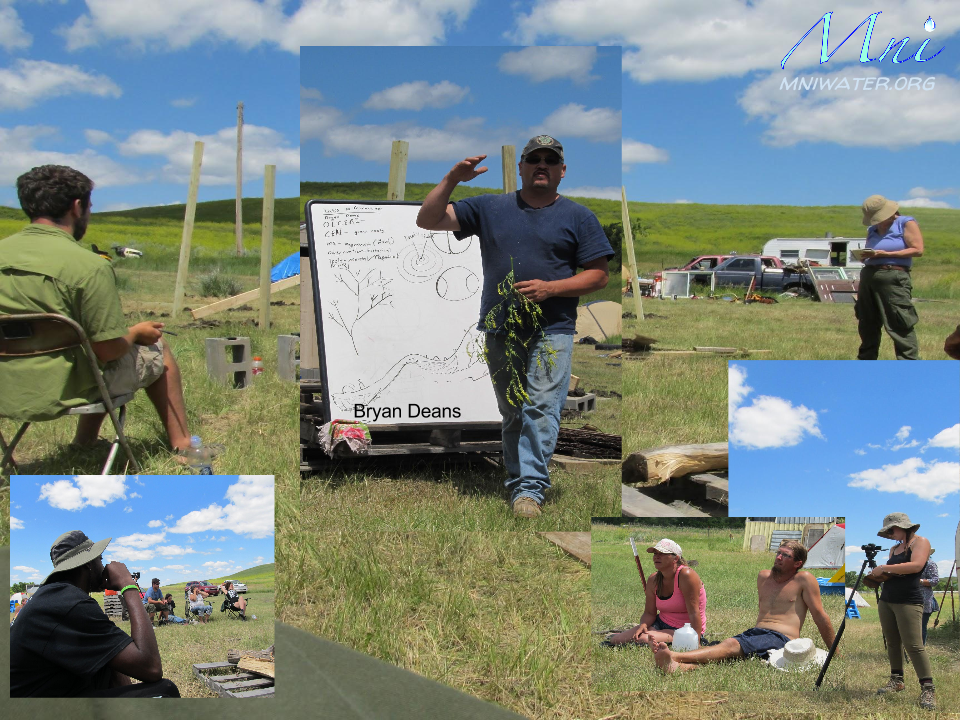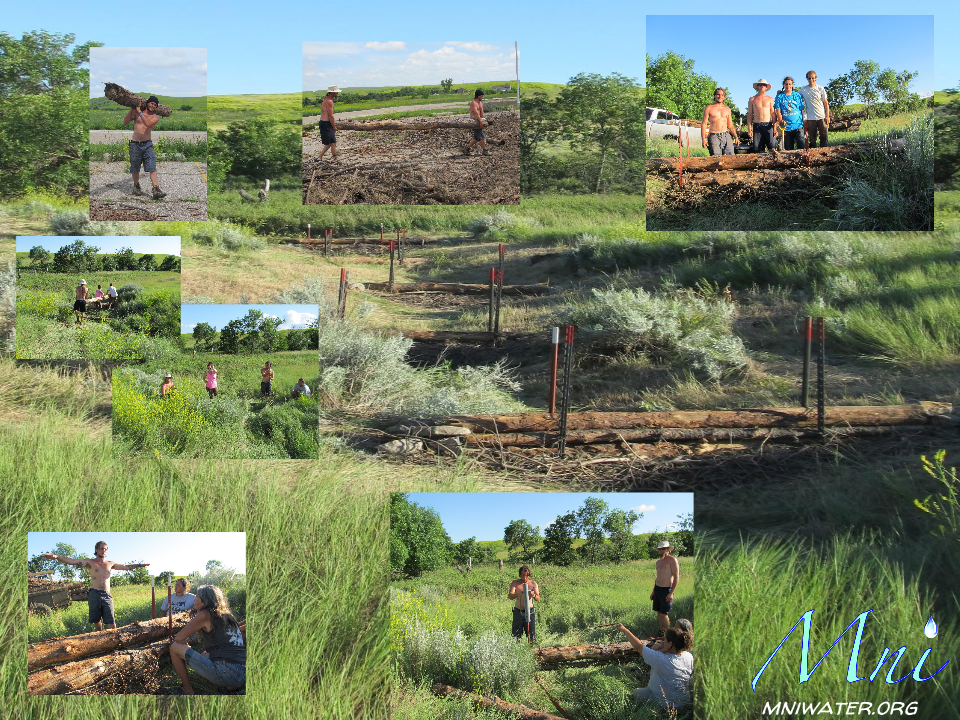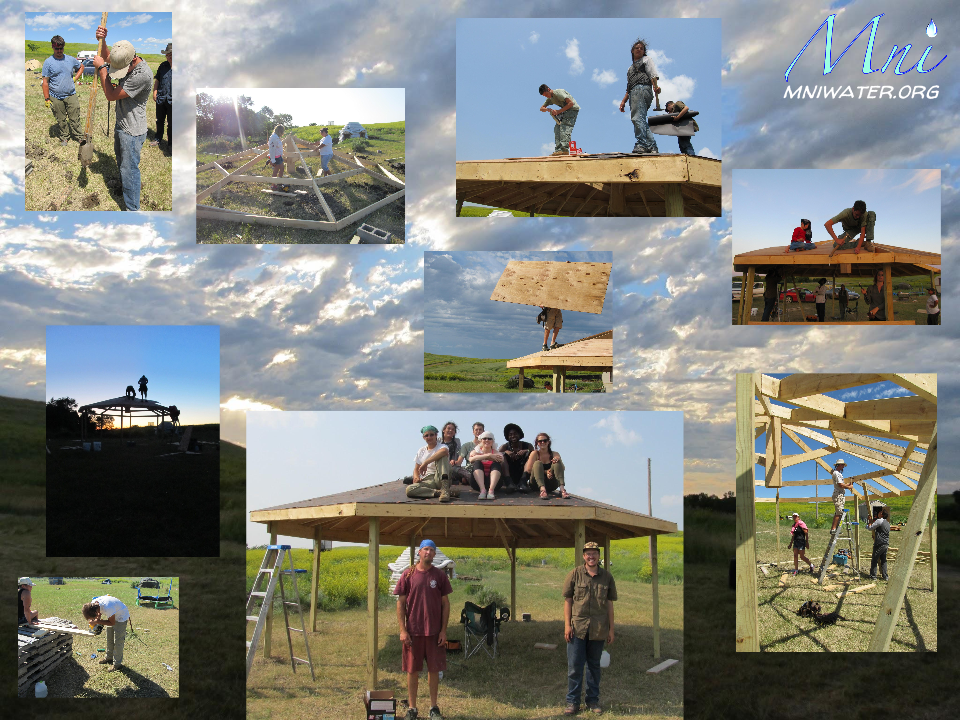By Ryan Reese | Mni Intern
The 2014 Mni Water Restoration Camp was held June 22nd to July 6th. During the two week training session, Mni was host to 35 volunteers and children. From the outset this entailed expenses in transportation and food to provide for the workers. The major funding sources for the Mni camp were late in releasing funds so the Global Giving donations, along with private monies, were used to make these initial purchases of gas and food. Without the Global Giving funds, this lapse in funding would have caused great hardship for participants in the Mni training camp project.
The Mni Water Restoration Camp was a successful effort in both practice and outreach. Through the help of multiple individuals and organizations, the combined projects of water restoration and holistic living at Tatanka Wakpala were accomplished, and the message of holistic land management and restoration was spread to those who attended the camp. Though faced with many difficulties, the participants at Mni persevered in the face of hardship and overcame the obstacles which they faced, and completed many of the projects which were begun.
The first week was spent preparing camp, creating facilities for future use, maintaining gardens, and surveying the land for water restoration potential. The area around the campsite was mowed, an outhouse was dug on an adjacent hill, and the mobile homes at the site were cleaned out for current and future use. The garden was weeded, furrows were dug, planting mounds were built, and seeds were planted. The stream bed was surveyed for potential dam sites, as were the surrounding hillsides and gullies. Over the course of the week, potential plans were discussed among members of the camp.
There were many different water restoration ideas presented by camp participants. The original goal of putting a few dams in the creek was put off to a future year, as high rainfall had raised the water level too much to allow easy access of the stream bed. At the best potential dam sites in the stream bed, the water was too deep to work with and the soil was quite waterlogged. Another proposition was to build trenches along isobars to hold rain water. Since the area around Tatanka Wakpala has few trees, this type of catchment would fit well with the materials in the area. Unfortunately, the hillsides where the trenches would be placed are also the best sites for home construction on the property, complicating the planning phase. In addition, the trenching machine that was going to be rented for the creation of these trenches had broken down, meaning that any trenches would have to be built with a different machine or dug by hand. For these reasons, the construction of trenches was put off for another year. Luckily, a large number of pine-beetle logs became available for our use for free, allowing us to small dams, or “baffles,” in the washes and gullies on the hillsides above the stream bank.
Over the course of the second week, plans for the dams were finalized. The first dams to be constructed were on the north side of the stream. Five different dams were built in a narrow gully, composed of logs, fence posts, earth, assorted branches and twigs, and barbed wire. These dams were spaced at 15 foot intervals, and were about 8 feet wide and 2 feet tall. Along the banks of the gully, cottonwood trees were planted to restore the ecology in the gully and to solidify the soil and prevent erosion.. On the south side of the stream, 13 dams were built in two different gullies, with six in one and seven in another. These were built with fewer materials, lacking the barbed wire and metal fence posts which the dams on the north side were built of.
A permanent octagonal shade was also built during the second week. The shade will be used for instruction at future camps and as a cook shack once it is complete. The majority of the work for the shade was completed, with only the completion of the roofing and the creation of bracing and supports remaining.
A permaculture workshop was also given during the Mni camp by Bryan Deans, a permaculturist on pine ridge. Mr. Deans walked over the property, discussing the principles and practice of permaculture, water restoration, and holistic management and how it related to the Mni project. That same week, an ethnobotanical tour was given by Linda. The participants at the Mni camp were taken across the property and shown the sacred medicines of the Lakota and told of their uses and cultural significance.
The Mni Water Restoration Camp was a success on many levels. The camp was able to implement part of its water restoration project as well as begin restoring the ecology in the area and reduce hillside erosion, as well as prepare the property for future camps and water restoration efforts. In addition, the camp successfully reached out to multiple organizations and many individuals, spreading knowledge of small-scale, holistic water restoration and building long-lasting relationships that will allow future collaboration on other water restoration projects. Furthermore, as the water restoration efforts proceed, they will act as a showcase for the methods practiced at Mni, testifying to the method’s feasibility and promoting its application in other areas. The Mni camp overcame the obstacles which it faced and attained the goals which it set out for itself and prepared future work in the field of water restoration.
Links:
Project reports on GlobalGiving are posted directly to globalgiving.org by Project Leaders as they are completed, generally every 3-4 months. To protect the integrity of these documents, GlobalGiving does not alter them; therefore you may find some language or formatting issues.
If you donate to this project or have donated to this project, you can receive an email when this project posts a report. You can also subscribe for reports without donating.


